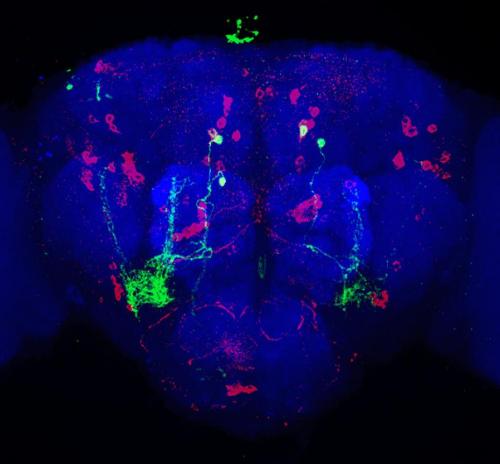Study beefs up support for brain cells that control protein hunger
NIH-funded research identifies cells in fly brains responsible for regulating protein levels.
Have you ever found yourself craving a steak or a burger? The brain controls our feelings of hunger and also determines the types of nutrients we should be seeking out. Not much is understood about the brain’s regulation of nutrient-specific hunger, but in a new study researchers identified the brain cells in fruit flies that regulate protein hunger and were able to control those cells, affecting what the animals ate.

Scientists looked at the brains of hungry fruit flies to investigate cells that regulate protein hunger.
To study protein hunger starved flies of yeast (the animal’s protein source) for one week. Afterwards, they discovered that the flies ate more yeast and less sugar than flies that ate a control diet.
“Flies have been a great model system for brain research so we can learn a lot about how our own brain circuits work by peeking inside the heads of flies,” said expert. “A better understanding of the basic mechanisms that regulate the consumption of different nutrients may help to provide clues to addressing the obesity epidemic.”
Using novel genetic tools, the researchers team identified a specific circuit, a set of brain cells that communicate with one another, which controls protein-seeking behavior. When the circuit was stimulated, flies ate more yeast than normal. In contrast, when the researchers turned off the circuit, the flies ate less yeast. The cells in the circuit were more active, which was demonstrated by increased firing activity, when the flies were starved of yeast. Turning the circuit on or off did not affect the animals’ general hunger or thirst.
The researchers also discovered that the circuit serves dual functions in regulating feeding. Following protein starvation, this circuit promotes protein feeding and also simultaneously suppresses sugar intake. One branch of the circuit is activated when the flies are deprived of protein, leading them to seek more protein and increase their consumption of that nutrient. Meanwhile, the other branch of the circuit acts to reduce interest in eating sugar when the flies are protein-starved.
“Adult flies usually have a sweet tooth, but when they are starved of protein, the brain makes it a priority to find this nutrient. Once they finally get some protein, the blockade on sugar feeding lifts but the flies still continue to be interested in eating protein,” said expert. “In this way, the circuit we identified promotes a single-minded focus on eating protein when the animal is protein-starved, but also allows for more flexible eating patterns with a continued preference for protein, when the need for protein is less.”
The researcher team are now trying to identify specific molecules involved in regulating protein hunger and plan to examine protein-specific hunger in mammals. They noted that this research may eventually have implications for obesity research, because the amount of protein in the diet significantly affects caloric intake.
Source: U.S. National Institutes of Health
- 288 reads
Human Rights
Ringing FOWPAL’s Peace Bell for the World:Nobel Peace Prize Laureates’ Visions and Actions

Protecting the World’s Cultural Diversity for a Sustainable Future

The Peace Bell Resonates at the 27th Eurasian Economic Summit

Declaration of World Day of the Power of Hope Endorsed by People in 158 Nations

Puppet Show I International Friendship Day 2020

